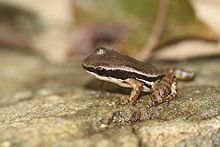| Colostethus pratti | |
|---|---|

| |
| Conservation status | |
 Least Concern (IUCN 3.1) | |
| Scientific classification | |
| Domain: | Eukaryota |
| Kingdom: | Animalia |
| Phylum: | Chordata |
| Class: | Amphibia |
| Order: | Anura |
| Family: | Dendrobatidae |
| Genus: | Colostethus |
| Species: | C. pratti |
| Binomial name | |
| Colostethus pratti (Boulenger, 1899) | |
| Synonyms | |
|
Phyllobates Pratti Boulenger, 1899 | |
Colostethus pratti is a species of frog in the family Dendrobatidae. It is found in the northwestern Colombia (Antioquia, Chocó, Córdoba, and Risaralda Departments) and Panama, possibly also in southeastern Costa Rica. It is sometimes known as the Pratt's rocket frog. Colostethus pratti is named after Antwerp Edgar Pratt, an explorer who collected the type series.
Description
Colostethus pratti is a small member of its genus; both males and females grow to about 24 mm (0.94 in) snout–vent length. It is brown above with characteristic dull paired dorsolateral stripes.
Reproduction
Reproduction of Colostethus pratti has been observed in captivity. Males have a loud, peeping advertisement call. They appear to establish small territories and can be aggressive against each other, engaging in "wrestling" bouts. Amplexus has not been observed but is presumably cephalic as in related species. Egg clusters contain 8-20 eggs. They are deposited on top of leaves or within plastic hiding places, primarily during a simulated wet season. Eggs hatch in 1–2 weeks. After hatching, the female transports the tadpoles to a body of water, carrying them on her back, sometimes for several days. No further parental care is provided. Tadpoles metamorphose 8–13 weeks after hatching. Newly metamorphosed froglets are 6–8 mm (0.24–0.31 in) in length. Some males start calling as soon as six months post-metamorphosis.
Habitat and conservation
Colostethus pratti is a common frog. Its natural habitats are humid lowland and montane forests where it occurs on the forest floor and along rocky sections of forest streams. Scientists observed it between 110 and 1600 meters above sea level.
The frog's known range includes several protected parks,including Los Katios National Park.
Agriculture, logging and pollution are threats to this species, although it is not considered threatened as a species due to its wide distribution and presumably large total population.
References
- ^ IUCN SSC Amphibian Specialist Group (2018). "Colostethus pratti". IUCN Red List of Threatened Species. 2018: e.T55135A54343915. doi:10.2305/IUCN.UK.2018-2.RLTS.T55135A54343915.en. Retrieved 14 November 2021.
- ^ Boulenger, G. A. (1899). "Descriptions of new batrachians in the collection of the British Museum (Natural History)". Annals and Magazine of Natural History. Series 7. 3: 273–277. doi:10.1080/00222939908678122.
- ^ Frost, Darrel R. (2014). "Colostethus pratti (Boulenger, 1899)". Amphibian Species of the World: an Online Reference. Version 6.0. American Museum of Natural History. Retrieved 3 December 2014.
- Acosta-Galvis, A.R. (2014). "Colostethus pratti (Boulenger, 1899)". Lista de los Anfibios de Colombia V.04.2014. www.batrachia.com. Archived from the original on 2 April 2015. Retrieved 3 December 2014.
- Beolens, Bo; Watkins, Michael; Grayson, Michael (2013). The Eponym Dictionary of Amphibians. Exeter, England: Pelagic Publishing Ltd. ISBN 978-1-907807-44-2.
- Savage, Jay M. (1968). "The dendrobatid frogs of Central America". Copeia. 1968 (4): 745–776. doi:10.2307/1441845. JSTOR 1441845.
- ^ Hill, R. L.; J. B. Kaylock; R. W. Gagliardo; E. K. Timpe; E. Griffith & H. Ross (2011). "Observations on the captive reproduction of Colostethus pratti". Herpetological Review. 42 (3): 365–367.
| Taxon identifiers | |
|---|---|
| Colostethus pratti | |
| Phyllobates pratti | |